Simple Short Angle System II
By Jim Shovak - Four Time USBA Tour "B" Champion
BASIC ENGLISHES CHART:
A more in-depth look at my last article and more. First, let's examine the Englishes. There are many different variations of these englishes, but these are the basic ones I use. You may have different names for these englishes, but this is how I name them.

4 Tips 3 1/2 Tips 3 Tips 2 Tips 1 Tip 0 Tips
Now let's look at the shot we looked at previously, only with a lot more detail.
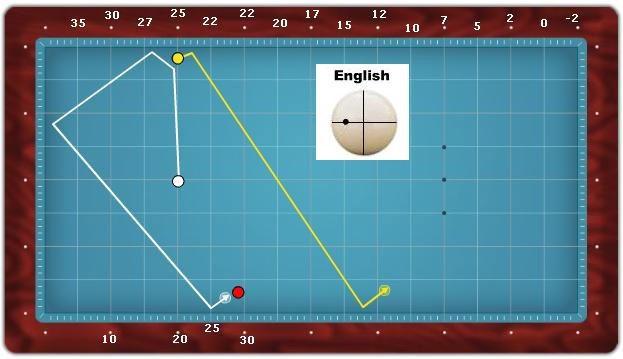
First, let's straighten some things out before you get scared. If your cue ball and the first object ball are lined up directly with the 2nd diamond on the long (top) rail, then the foundation shot is this: 4 tips of English, ½ ball hit, soft follow-through stroke. Your cue ball will hit 25 on the 3rd (bottom) rail. This is only true if your cue ball and the first object ball are separated by a distance of around 2 diamonds or more. When the balls are closer, it changes. That's another lesson.
By looking at the numbers listed on the top long rail, you will see that this is the map whereby you will know where your cue ball wants to hit the 3rd (bottom) rail if the first 2 balls (your cue ball and the first object ball) are lined up directly with those numbers. For example, if the first 2 balls are lined up directly with the middle diamond on the top long rail, then your cue ball will hit 17 on the 3rd rail (bottom) if you use 4 tips of English, a ½ ball hit and a soft follow-through stroke. I prefer to use the numbers 7 and 2 all the time instead of 7½ and 2½ and 17½ and 22½. To keep it simple, I call it 22, 17, 32, 37, etc.,
This “map” comes in handy especially if the first 2 balls are lined up with the number 2 and you have a “difficult” shot where you need to go directly into the corner. The number 2 equals the corner. This “difficult” shot is now a “gimme”. Just remember to execute properly and the shot is made. The number 0 equals just shy of the corner. This comes in handy if you want to play a drop-in shot just missing the corner. It now becomes a much easier shot. The number -2 (minus 2) misses the corner even more and is ideal for many “difficult” drop-in shots in the corner area.
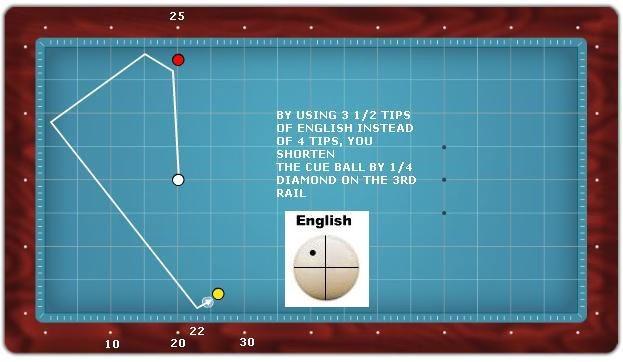
To make the shot above, use the next lower English which is 3½ tips (high maximum). I call this English “minus 2 english” because it takes you ¼ diamond shorter. Notice that with this hit on the first object ball, you should get a nice position with several shot options.
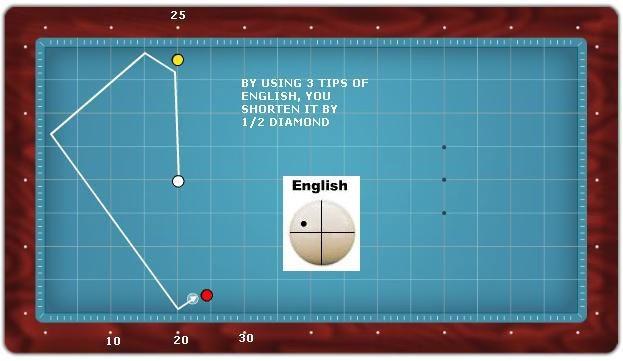
For this shot, use 3 tips of English. I call this “minus 5 english”: 3 tips and a ½ ball hit = minus 5
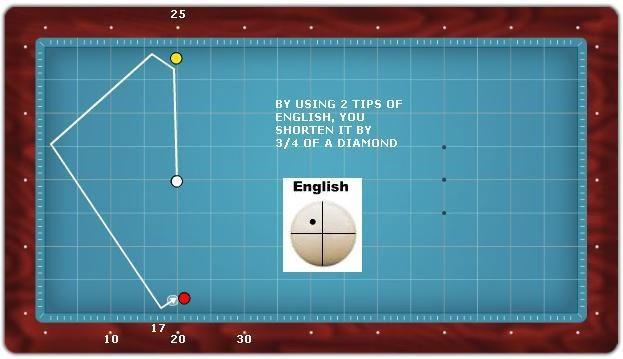
Above, you want to go “minus 7” (25 is the foundation and you want to go to 17), use 2 tips, ½ ball hit.
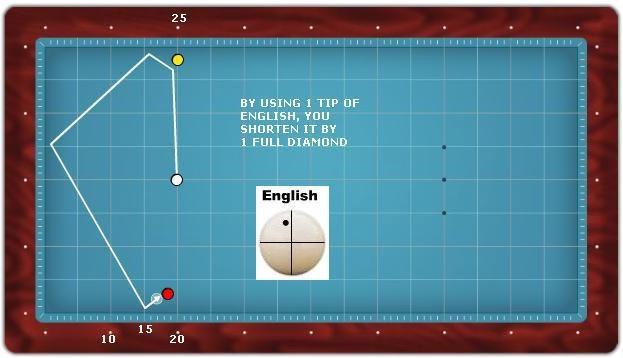
To get to 15, use “minus 10” English. One tip and ½ ball hit.
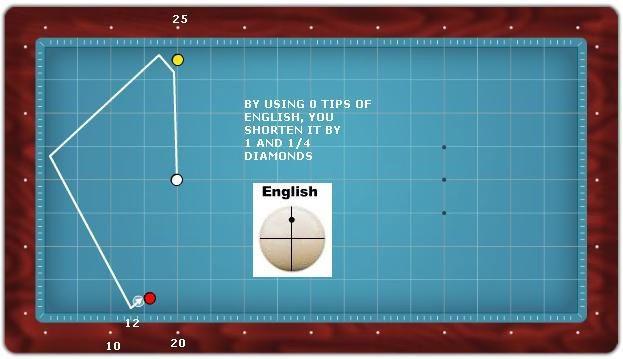
Finally, to get to 12, use “minus 12” English. Zero tips high ball and ½ ball hit. If you wish your cue ball to hit 10, 7, 5, 2, 0 (missing the corner), then you can no longer hit the first object ball ½ full, at least not comfortably. You would then have to use “Alternate Englishes”.
Alternate englishes may also need to be used if the last ball (3rd ball) is in the path of the first object ball shown throughout the diagrams. We don't want a kiss, so an alternate English and hit would be needed to avoid that.
First, to get your cue ball to hit 10, use “minus 15” English, which is ½ tip English and a ¼ ball hit.
To get to 7, use “minus 17” English, which is center ball on the cue ball and a 1/8 object ball hit.
To get to 5, use “minus 20” English, which is a Zero English high ball and 1/8 object ball hit.
To get to 2, use “minus 22” English, which is a zero English high ball and a 1/16 object ball hit.
To miss the corner, use “minus 25” English, which is slight high reverse and a 1/8 ball hit.
For the diagrammed shots that may have a kiss, here are other alternate englishes and hits:
Cue ball to 25: Same “foundation” result: One tip English, ¾ ball hit, slightly harder.
Cue ball to 25: Same “foundation” result: 4 tips English, ¼ ball hit, with speed.
Cue ball to 22: “Minus 2” English: ½ tip English, ¾ ball, slightly harder
Cue ball to 22: “Minus 2” English: 4 tips English, ¼ ball, medium speed
Cue ball to 20: “Minus 5” English: 0 tips high, ¾ ball, slightly harder
Cue ball to 20: “Minus 5” English: 4 tips English, ¼ ball, soft
Cue ball to 17: “Minus 7” English: 3 ½ tips English, ¼ ball, soft
Cue ball to 15: “Minus 10” English: 2 tips English, ¼ ball, soft
Cue ball to 12: “Minus 12” English: 1 tip English, ¼ ball, soft
I know this is a lot to digest. Practice it and you'll see. Most of the englishes work throughout the entire table (foundation, minus 2, minus 5 and minus 7 englishes). Others change depending on how far you get from the corner (the lower numbers on the “map”). Practice and you'll see what I mean. Hope this helps you to never miss this type of short angle again. However, make sure you miss it when you play me.


